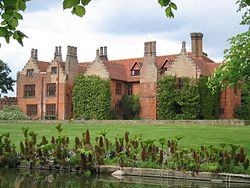Ingatestone Hall
| Ingatestone Hall | |
| Essex | |
|---|---|
 Ingatestone Hall | |
| Location | |
| Grid reference: | TQ65319862 |
| Location: | 51°39’42"N, -0°23’25"E |
| Village: | Ingatestone |
| History | |
| Country house | |
| Information | |
Ingatestone Hall is a Grade I listed 16th-century manor house in Essex some 5 miles southwest of Chelmsford. It was built by Sir William Petre, and his descendants (the Petre Baronets) live in the house to this day.
The building comprises three wings (north, east and south) around a central court. Originally there was also a west range. The Hall has two priest holes. Among the priests to have been at the hall was John Payne who was executed in 1582.
William Petre bought Ingatestone manor soon after the Dissolution of the Monasteries for some £850 and commissioned the building of the house. Queen Elizabeth I spent several nights there on her royal progress of 1561. In the late 18th century the west wing which contained the Great Hall was demolished and the house modernised and divided into rented apartments. Following WWI a long period of restoration returned the hall to its original Tudor appearance. The hall itself has been grade I listed, the gatehouse grade II* listed and several of the outhouses listed Grade II.
The hall is opened to the public on selected afternoons between Easter and September.
On television and literature
- Bleak House (television adaptation, 2005): The hall represented the exterior of Bleak House
- Lovejoy: appearance in one episode
- Lady Audley's Secret, a novel by Mary Elizabeth Braddon's novel is set at Ingatestone Hall and was inspired by a stay there.[1]
Outside links
References
- Ingatestone Hall
- Description of House
- History of Ingatestone, Essex
- touruk.co.uk page
- Exploring Britain's Historic Houses.